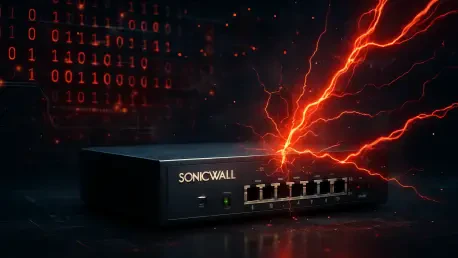In a chilling reminder of the evolving cyberthreat landscape, organizations relying on SonicWall firewalls have become prime targets for a sophisticated ransomware campaign. Since late July, threat actors have been deploying Akira ransomware with alarming speed and precision, exploiting vulnerabilities in SonicWall SSL VPNs to infiltrate networks across multiple industries. Identified by cybersecurity experts, this ongoing attack wave reveals how even patched systems remain at risk due to historical credential theft. The audacity of bypassing multi-factor authentication (MFA) and the rapid progression from access to encryption—sometimes in under an hour—paints a stark picture of the challenges facing modern cybersecurity defenses. As attackers leverage stolen credentials and advanced tactics, the urgency to rethink security strategies has never been clearer.
Unpacking the Attack Mechanism
Exploiting Historical Vulnerabilities
The foundation of this ransomware campaign lies in the exploitation of past weaknesses in SonicWall devices, specifically tied to an improper access control flaw known as CVE-2024-40766, disclosed earlier in 2024. Threat actors are using credentials likely harvested from devices that were once vulnerable, allowing them to access even patched systems through malicious SSL VPN logins. Often originating from Virtual Private Server (VPS) hosting providers rather than typical corporate networks, these logins bypass security measures like SonicWall’s One-Time Password (OTP) feature. This tactic dispels earlier concerns of a zero-day exploit but highlights a critical oversight: patching alone does not mitigate the risk if stolen credentials remain in play. The ability to infiltrate networks using old data underscores the persistent danger of credential theft and the need for organizations to prioritize resetting all SSL VPN and Active Directory credentials as a fundamental defense strategy against such opportunistic attacks.
Rapid Progression to Ransomware Deployment
Once inside the network, attackers waste no time, with dwell times as short as 55 minutes before deploying Akira ransomware. The attack sequence begins with internal scanning for open ports such as SMB, RPC, and SQL, using tools like Impacket and Advanced IP Scanner to map out the environment for lateral movement. Privilege escalation follows, often through the creation of new administrator accounts, ensuring continued access. Remote management tools like AnyDesk and TeamViewer are installed for persistence, while endpoint security solutions, including Windows Defender, are disabled through kernel-level tampering. To prevent recovery, attackers delete Volume Shadow Copies before encrypting data with executables named akira.exe or locker.exe. This multi-stage process, executed with ruthless efficiency, demonstrates how quickly a breach can escalate into a full-blown crisis, leaving little room for response unless proactive monitoring and rapid detection mechanisms are already in place.
Strengthening Defenses Against Evolving Threats
Importance of Credential Hygiene
Addressing the root cause of these attacks requires a laser focus on credential hygiene, as historical exposures continue to haunt organizations long after vulnerabilities are patched. Resetting all credentials associated with SonicWall SSL VPNs and related Active Directory accounts is not just a recommendation but a critical necessity, especially for devices that may have run vulnerable firmware in the past. Beyond this, implementing strict policies for regular credential rotation can significantly reduce the risk of compromised data being weaponized. Additionally, organizations must scrutinize VPN logins for anomalies, particularly those originating from hosting providers rather than expected corporate sources. By prioritizing these measures, the window of opportunity for attackers to exploit stolen credentials narrows considerably, offering a vital layer of protection against ransomware campaigns that thrive on outdated access points.
Enhancing Detection and Response Capabilities
Equally important is the need to bolster detection and response frameworks to counter the speed of modern ransomware attacks. Continuous monitoring for suspicious network activity, such as the use of tools like Impacket for lateral movement, can serve as an early warning system to disrupt attackers before encryption begins. Deploying advanced threat detection solutions that identify anomalous behaviors tied to privilege escalation or the installation of remote management software is another crucial step. Furthermore, maintaining robust incident response plans ensures that teams can act swiftly to isolate affected systems and mitigate damage. The rapid dwell times observed in this campaign underscore the limitations of reactive measures; thus, investing in proactive strategies becomes essential to stay ahead of threat actors. By integrating these practices, organizations fortify their ability to withstand the relentless pace of cyberthreats that evolve with alarming sophistication over time.









